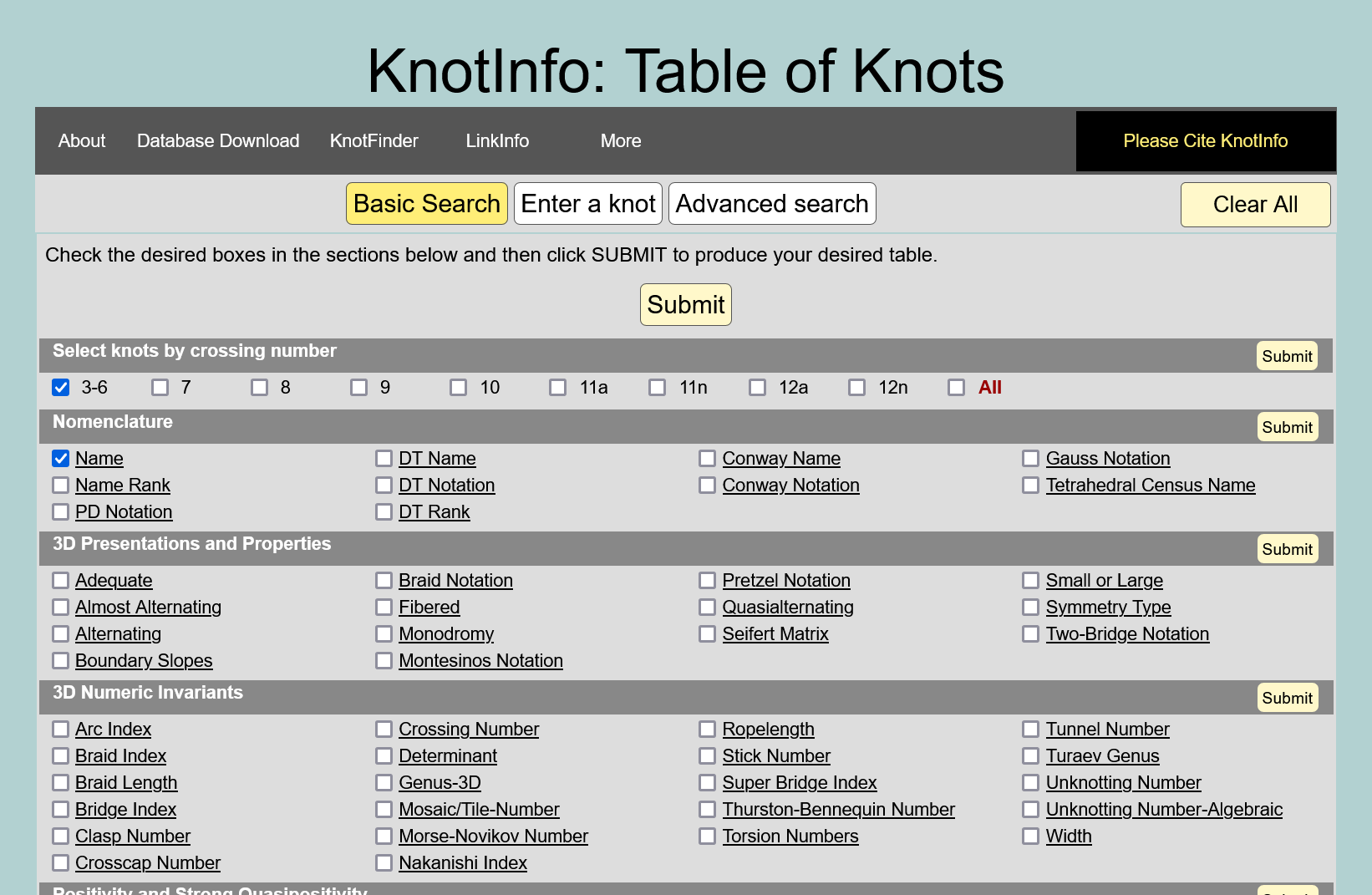$\newcommand{\N}{\mathbb{N}} \newcommand{\Z}{\mathbb{Z}} \newcommand{\Q}{\mathbb{Q}} \newcommand{\R}{\mathbb{R}} \newcommand{\LP}{\left(} \newcommand{\RP}{\right)} \newcommand{\LS}{\left\lbrace} \newcommand{\RS}{\right\rbrace} \newcommand{\LA}{\left\langle} \newcommand{\RA}{\right\rangle} \newcommand{\LB}{\left[} \newcommand{\RB}{\right]} \newcommand{\MM}{\ \middle|\ } \newcommand{\exp}{\text{exp}} \newcommand{\abs}[1]{\left\vert#1\right\vert} \newcommand{\msr}[1]{m\left(#1\right)} \newcommand{\inv}[1]{#1^{-1}} \newcommand{\bkt}[1]{\LA \img{#1}\RA} \require{color}$
U of M - Dearborn Colloquium (11/15/23)
The Tanglenomicon
Zachary Bryhtan, Nicholas Connolly, Isabel Darcy, Ethan Rooke, Joseph Starr*
Mathematics Department at The University of Iowa
Knots
“A knot is a smooth embedding of a circle $S^1$ into Euclidean 3-dimensional space $\R^3$ (or the 3-dimensional sphere $S^3$ ).”
Jablan, S., & Sazdanović, R. (2007). Linknot. In Series on Knots and Everything. WORLD SCIENTIFIC. https://doi.org/10.1142/6623
Knot Equivalence
reidemeister moves
Type I
Type II
Type III
The natural question
Knot Tables

- 1860’s Tait computes knots up to 7 crossing
- 15 knots
- 1870’s Tait, Kirkman, and Little compute knots up to 10 crossing
- Takes about 25 years
- 250 knots
- 1960’s Conway computes knots up to 11 crossings
- “A few hours”
- 802 knots
- 1980’s Dowker and Thistlethwaite compute up to 13 crossings
- First using a computer
- 12,966
- 1990’s Hoste, Thistlethwaite, and Weeks compute up to 16 crossings
- Computer runtime on the order of weeks
- 1,701,936
- 2020’s Burton computes up to 19 crossings
- 350 Million
KnotInfo

Conway
Tangles
“We define a tangle as a portion of a knot diagram from which there emerge just 4 arcs pointing in the compass directions NW, NE, SW, SE.”
Conway, J.H. “An Enumeration of Knots and Links, and Some of Their Algebraic Properties.” In Computational Problems in Abstract Algebra, 329-58. Elsevier, 1970. https://doi.org/10.1016/B978-0-08-012975-4.50034-5
Basic Operations
Operation $+$
Operation $\vee$
The Tanglenomicon
Building up
Where we are
Rational Tangles
Generation
For any $N$ an obvious twist vector is the twist vector of all $1$s $$[1\ 1\ 1\ \cdots\ 1]$$ Noting that when we write this sequence we have $N-1$ spaces.
If we choose to place a $+$ instead of the left most space we get $$[1+1\ 1\ \cdots\ 1]=[2\ 1\ \cdots\ 1]$$ we’re free to make this choice for each space
this gives $N-1$ choices between ‘$+$’ and space $$[1\square 1\square 1\square\cdots\square1]$$ letting us generate twist vectors by simply counting from $0\to 2^{N-1}$.
Canonical Twist Vectors
We can write a canonical twist vector by taking the odd length vectors (appending $0$ where needed).
Programmatic Description
Computations
Rational Number (continued fraction)
The rational number for a twist vector is computed by taking the twist vector as a finite continued fraction that is: $$\LB a\ b\ c\RB=c+\frac{1}{b+\frac{1}{a}}$$
Louis H. Kauffman and Sofia Lambropoulou. Classifying and applying rational knots and rational tangles. In DeTurck, editor, Contemporary Mathematics, volume 304, pages 223-259, 2001
To play with twist vectors and continued fractions visit
https://joe-starr.com/resources/cont_frac_convert/
Parity
Computing Parity
If we take the rational number $\frac{p}{q}$ associated with the rational tangle we get the following correspondence for parity
Closures
Closure Equivalence and pivoting to knots
(1) $p=p^{\prime}$
(2) either $q \equiv q^{\prime}(\bmod p)$ or $q q^{\prime} \equiv 1(\bmod p)$.
Schubert, Horst. “Knoten mit zwei Brücken..” Mathematische Zeitschrift 65 (1956): 133-170. http://eudml.org/doc/169591.
Using The Tanglenomicon
Where we’re going
Montesinos
Existence of canonical diagrams for Montesinos tangles
F. Bonahon and L. Siebenmann, New geometric splittings of classical knots, and the classification and symmetries of arborescent knots, http://www-bcf.usc.edu/~fbonahon/Research/Publications.html
Generation
The Montesinos tangles of crossing number $N$ have a slightly simpler generation strategy compared to rational tangles. We again generate twist vectors but require that each entry $e$ of the twist vector satisfies $2\leq e < N.$ We call these restricted set of twist vectors stencils.
Now for each entry $e_i$ of the stencil, we generate a list of rational tangles of crossing number equal to $e_i$, with the restriction $0<\frac{p_i}{q_i}<1$. We then take all combinations of elements of these lists.
Generalized Montesinos
Operation $\circ$
Generation
We just need to take our lists of Montesinos and rational tangles and glue them together with $\circ$.
Into the future
Algebraic
All possible tangles made from $+$ and $\vee$
Generation
Caudron Trees
To generate all possible algebraic tangles, we can generate all possible algebraic expressions on the trivial tangles. Equivalently, all full binary trees with $N$ leaves. Where the tree’s internal nodes are labeled with combinations of $\vee$ and $+$ and leaves are labeled with all combinations of trivial tangles.
These binary trees are called Caudron Trees.
Alain Caudron. Classification des nœuds et des enlacements, volume 4 of Publications Math ́ematiques d’Orsay 82 [Mathematical Publications of Orsay 82]. Universit ́e de ParisSud, D ́epartement de Mathe ́matique, Orsay, 1982.
Non-algebraic/Polygonal
4-valent planar graphs
4-valent planar graph insertions
Generation
There exist tables of 4 valent graphs. We can use those with insertions from our list of algebraic tangles to generate all polygonal tangles.
Tooling
Design Goals
The design for The Tanglenomicon project prioritizes flexibility and extensibility. We want a feature, maybe “calculate Jones polynomial,” to be runnable in a jupyter notebook or on a university cluster. We’re aiming for a “write once deploy anywhere” design.
To that end we’ve decoupled functionality wherever feasible, taking a layered approach for system design.
Runners
A runner is a human/machine interface layer. This abstracts the routines in lower layers for a user to interact with. This could be a CLI, python binding, a Mathematica wrapper, or a web API.
Runnables
Generators
Generators create new data. A generator might look like a module to create rational tangles. They may use one or more Computations, Notations, or Translators.
Computation
Computations compute a value for a given data. A computation might look like a module for computing a Jones polynomial of a link, or a computing the writhe of a tangle.
Translators
Translators define a conversion between two Notations. A translator might look like a module for converting from PD notation to Conway notation and back again.
Data Wranglers
Notations
Notations define a notational convention for a link/tangle. They describe a method for converting to and from a string representation of a link/tangle and data structure describing that link/tangle.
Storage
A storage module defines a storage interface for the application. The main inter-module type is string and the calling module is responsible for en/decoding the string with a notation module.
Technologies
Sources
- Dror Bar-Natan The Most Important Missing Infrastructure Project in Knot Theory
- Kauffman, L. H., and S. Lambropoulou. “From Tangle Fractions to DNA.” In Topology in Molecular Biology, edited by Michail Ilych Monastyrsky, 69-110. Biological and Medical Physics, Biomedical Engineering. Berlin, Heidelberg: Springer Berlin Heidelberg, 2007. https://doi.org/10.1007/978-3-540-49858-2_5.
- Moon, Hyeyoung, and Isabel K. Darcy. “Tangle Equations Involving Montesinos Links.” Journal of Knot Theory and Its Ramifications 30, no. 08 (July 2021): 2150060. https://doi.org/10.1142/S0218216521500607.
- Conway, J.H. “An Enumeration of Knots and Links, and Some of Their Algebraic Properties.” In Computational Problems in Abstract Algebra, 329-58. Elsevier, 1970. https://doi.org/10.1016/B978-0-08-012975-4.50034-5.
- Louis H. Kauffman and Sofia Lambropoulou. Classifying and applying rational knots and rational tangles. In DeTurck, editor, Contemporary Mathematics, volume 304, pages 223-259, 2001
- Alain Caudron. Classification des nœuds et des enlacements, volume 4 of Publications Math ́ematiques d’Orsay 82 [Mathematical Publications of Orsay 82]. Universit ́e de ParisSud, D ́epartement de Mathe ́matique, Orsay, 1982.
- Robert Glenn Scharein. Interactive topological drawing. ProQuest LLC, Ann Arbor, MI, 1998. Thesis (Ph.D. The University of British Columbia (Canada). URL: https://www.knotplot.com/.
- Jablan, S., & Sazdanović, R. (2007). Linknot. In Series on Knots and Everything. WORLD SCIENTIFIC. https://doi.org/10.1142/6623
- Dowker, C. H., & Thistlethwaite, M. B. (1983). Classification of knot projections. In Topology and its Applications (Vol. 16, Issue 1, pp. 19-31). Elsevier BV. https://doi.org/10.1016/0166-8641(83)90004-4
- Hoste, J., Thistlethwaite, M., & Weeks, J. (1998). The first 1,701,936 knots. In The Mathematical Intelligencer (Vol. 20, Issue 4, pp. 33-48). Springer Science and Business Media LLC. https://doi.org/10.1007/bf03025227
- Burton, B. A. (2020). The Next 350 Million Knots. Schloss Dagstuhl - Leibniz-Zentrum Für Informatik. https://doi.org/10.4230/LIPICS.SOCG.2020.25
- C. Livingston and A. H. Moore, KnotInfo: Table of Knot Invariants, knotinfo.math.indiana.edu, today’s date (eg. August 24, 2023).
- Schubert, Horst. “Knoten mit zwei Brücken..” Mathematische Zeitschrift 65 (1956): 133-170. http://eudml.org/doc/169591.
- Jos ́e M. Montesinos. Seifert manifolds that are ramified two-sheeted cyclic coverings. Bol. Soc. Mat. Mexicana (2), 18:1-32, 1973.
- F. Bonahon and L. Siebenmann, New geometric splittings of classical knots, and the classification and symmetries of arborescent knots, http://www-bcf.usc.edu/~fbonahon/Research/Publications.html